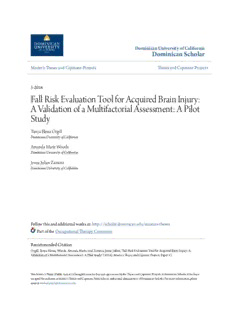
Fall Risk Evaluation Tool for Acquired Brain Injury PDF
Preview Fall Risk Evaluation Tool for Acquired Brain Injury
DDoommiinniiccaann SScchhoollaarr Graduate Master's Theses, Capstones, Student Scholarship and Culminating Projects 5-2014 FFaallll RRiisskk EEvvaalluuaattiioonn TTooooll ffoorr AAccqquuiirreedd BBrraaiinn IInnjjuurryy:: AA VVaalliiddaattiioonn ooff aa MMuullttiiffaaccttoorriiaall AAsssseessssmmeenntt:: AA PPiilloott SSttuuddyy Tanya Elesia Orgill Dominican University of California Amanda Marie Woods Dominican University of California Josue Julian Zamora Dominican University of California https://doi.org/10.33015/dominican.edu/2014.OT.13 Survey: Let us know how this paper benefits you. Recommended Citation Orgill, Tanya Elesia; Woods, Amanda Marie; and Zamora, Josue Julian, "Fall Risk Evaluation Tool for Acquired Brain Injury: A Validation of a Multifactorial Assessment: A Pilot Study" (2014). Graduate Master's Theses, Capstones, and Culminating Projects. 13. https://doi.org/10.33015/dominican.edu/2014.OT.13 This Master's Thesis is brought to you for free and open access by the Student Scholarship at Dominican Scholar. It has been accepted for inclusion in Graduate Master's Theses, Capstones, and Culminating Projects by an authorized administrator of Dominican Scholar. For more information, please contact [email protected]. Fall Risk Evaluation Tool for Acquired Brain Injury: A Validation of a Multifactorial Assessment A Pilot Study A Master Thesis Project Tanya Orgill Amanda Woods Josué Zamora A Thesis Submitted in Partial Fulfillment of the Requirements for the Degree Master of Science in Occupational Therapy School of Health and Natural Sciences Dominican University of California San Rafael, California May 2014 ii This thesis, written under the direction of the candidates’ thesis advisor and approved by the Chair of the master’s program, has been presented to and accepted by the Faculty of the Occupational Therapy department in partial fulfillment of the requirements for the degree of masters of Science in Occupational Therapy. The content, project, research, and methodologies presented in this work represent the work of the candidates alone. Tanya Orgill, Candidate 5/1/2014 Amanda Woods, Candidate 5/1/2014 Josué Zamora, Candidate 5/1/2014 Dr. Ruth Ramsey, Ed.D., OTR/L, Chair 5/1/2014 Dr. Kitsum Li, OTD, OTR/L, Thesis Advisor 5/1/2014 iii ©Copyright by Tanya Orgill, Amanda Woods, and Josué Zamora (2014). All Rights Reserved. iv Acknowledgements It is with great pleasure that we thank those that contributed to our successful thesis completion. We would like express our deep appreciation and gratitude to our thesis advisor, Kitsum Li, OTD, OTR/L for her unwillingness to allow us to do less than our best work every step of the way. Her guidance, endless support, enthusiasm, and time have made our thesis an exceptional educational experience. It is our pleasure to congratulate and acknowledge one another for our hard work and dedication to the project. In addition, we would like to thank Dominican University Occupational Therapy staff for educating and guiding us these past three years. This master thesis would not have been possible without the expertise and wisdom of Mark McAlister. He generously spent many hours with our group compiling our results and helping to complete the data analysis. We would like to thank the Brain Injury Network of the Bay Area for allowing us to spend countless hours conducting our research at their site. Furthermore, we would like to thank the acquired brain injury population as a whole. We hope this research provides a way for professionals to increase your safety in the future. Lastly, we wish to express appreciation to our wonderful family members, friends, and classmates for their endless support, encouragement, and patience throughout our duration at Dominican University of California. v Table of Contents Contents Page Introduction……………………………………………………………… 1 Literature Review ………………………………………………………. 2 Acquired Brain Injuries…………………………………………. 3 Fall Risk in Individuals with Acquired Brain Injuries………….. 3 Fall Risk in Community-Dwelling Elderly……………………... 6 Similarities in Individuals with Acquired Brain Injuries and Community-Dwelling Elderly………………………….. 8 Risk Assessments……………………………………………….. 8 FRETT……………………………………………………. 8 Fall History …………………………………………….. 9 Use of Psychotropic Drugs……………………………… 10 Timed Up and Go Cognitive……………………………. 10 Trail Making Test Part B……………………………….. 11 Confrontation Testing…………………………………... 12 Functional Depth Perception……………………………. 12 Contrast Sensitivity Test………………………………... 13 Reliability and Validity…………………………………………. 14 Sensitivity and Specificity……………………………………… 15 Conclusion……………………………………………………… 15 Statement of Problem…………………………………………… 16 vi Purpose of Study………………………………………………..….…… 16 Research Questions………………………………………………..….… 17 Theoretical Framework…………………………………………………. 17 Definitions and Variables………………………………………………. 23 Ethical and Legal Considerations………………………………………. 24 Methodology……………………………………………………………. 25 Design…………………………………………………………… 25 Subject Recruitment………………………………….……….… 26 Data Collection Procedures…………………………...………… 27 Instrument……………………………..…………….….. 27 Procedures……………………………..………….…….. 27 Fall Risk Reduction Education Workshop…….…………….….. 28 Results………………………………………………………..…………. 29 Population………………………………………..………….….. 29 Inter-rater Reliability…………………………………………… 31 Validity…………………………………………………………. 31 Discussion……………………………………………………….…….… 35 Research Question #1…………………………………….….…. 36 Research Question #2…………………………………….….…. 37 Limitations………………………………………………………….…… 37 Conclusion………………………………………………………………. 38 References.…………………………………………………………...…. 39 vii Appendices Appendix A: Institution Review Board Approval Appendix B: Permission from Agency Director Appendix C: Saint Louis University Mental Status Examination Appendix D: Recruitment Flyer Appendix E: Craiglist Post Appendix F: Bill of Rights Appendix G: Consent Form Appendix H: Proxy Consent Form Appendix I: Fall Risk Evaluation Tool Appendix J: Demographic form Appendix K: Fall Journal Appendix L: Standardized Phone Call Script Appendix M: Fall Risk Reduction Education Workshop Handouts viii List of Figures Page Figure 1: Fall Risk Determinant………………………………………… 20 Figure 2: Fit for Inter-Rater Reliability………………………………… 22 Figure 3: Risk Rank vs. Fall Incidence Rank…………………………… 34 ix List of Tables Page Table 1: Participant Demographic…………………………………… 30 Table 2: Fall Risk and Incidence…………………………………….. 32
Description: